
Early spring 2007, while photographing a billfish tournament off Miami, I gazed at an image of a swordfish caught and released midmorning.
“I thought it was a free-jumping sailfish, but it looked different when it hit the water on the last jump,” said Capt. John Dudas, who was running Wound Up in the ESPN-televised BXRL fishing tournament. A quick quarter-mile move ahead of the fish, followed by a few antsy moments feeding it, finally paid off with a six-figure tournament-win payout.
At that time, captains Richard and Scott Stanczyk in Islamorada, and R.J. Boyle in Hillsboro, Florida, were deep-dropping for swordfish but not yet broadcasting their success. The thought of hooking a broadbill by day in the Atlantic Ocean — and winning a tournament with it — was preposterous.
Yet now, 12 anglers I contacted around the globe regularly battle these billfish in daylight — and moonlight — in ways unimaginable a decade ago.
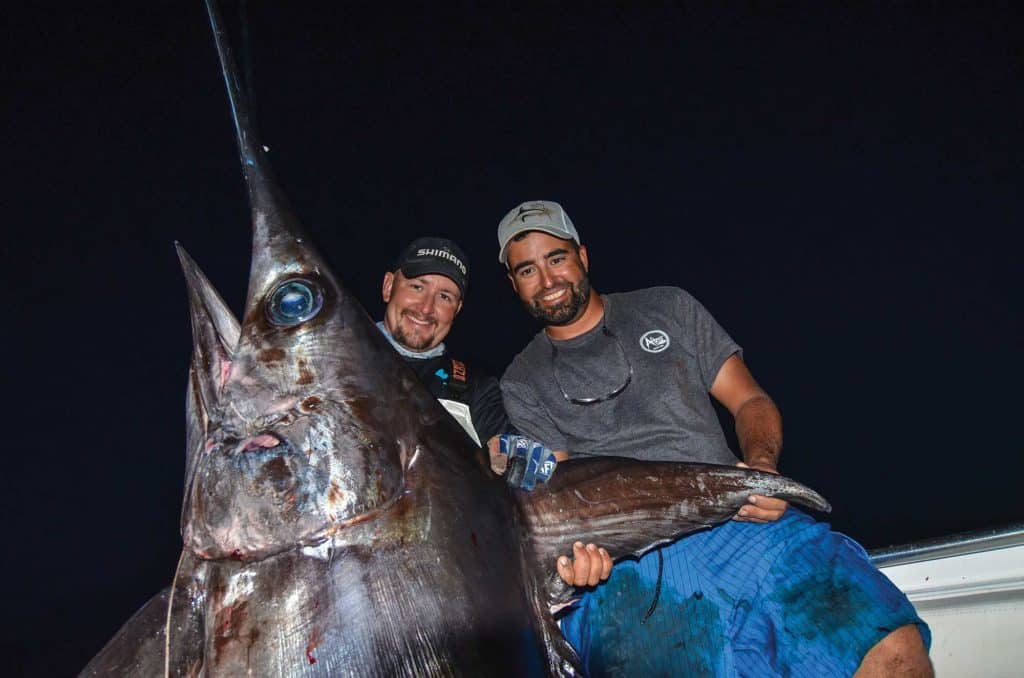
Catching Fire
“Once we started pulling up fish off the bottom, we knew it was just a matter of time before it spread like wildfire,” Boyle says. “A swordfish is much stronger than a blue marlin. Look at the [muscular] base of the tail. The dorsal is fixed, not folding, and it has that big, flat bill,” allowing swordfish to dig deep in long fights against anglers largely unaided by boat and captain. “Catching a 200-pound sword takes three times longer than a 200-pound blue marlin,” Boyle says.
Daytime swordfishers are also showing that broadbills can be targeted almost anywhere. “Swordfish and blue marlin coexist over very broad ranges,” says Dr. John Graves, who heads the Department of Fisheries Science at Virginia Institute of Marine Science. “Except in shallow waters, one would expect swordfish biomass to be much greater, although they might not be all that available to recreational anglers.”
However, that availability is now changing, leading top skippers to target them alongside other billfish, sometimes with spectacular results. Not quite two years ago off Virginia Beach, Virginia, Full Pull released a spearfish, a blue marlin, a sailfish and a white marlin before lunchtime. “Let’s try for the fantasy slam”(catching all billfish species in a single day), Capt. Ryan Riggs told his crew.
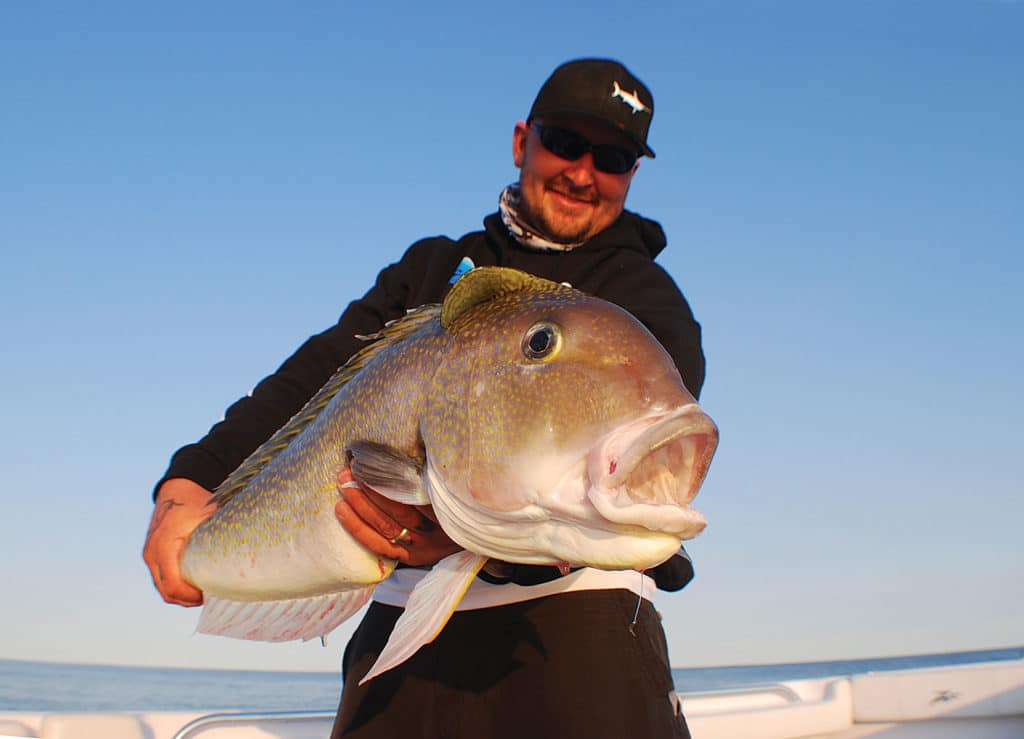
Riggs regularly pulled swordfish from beneath the Gulf Stream off Charleston, South Carolina, but he knew that current moving at just a half-knot over Norfolk Canyon posed different challenges. For advice, Riggs called Boyle, whom he knew had recently experimented for swords in the region. The 60-pound swordfish they pulled up on the third drop that day gave Full Pull the first-ever five-billfish-species day off the East Coast.”
I used to think we needed current to catch swordfish, to make time over the bottom,” Riggs says. “Now, seeing what they do in the canyons, using a lighter lead and bump-trolling to cover ground, I started having success on days when the Gulf Stream’s current is offshore [of Charleston’s prime swordfish grounds].”
Riggs says the daytime swordfishing spark had already lit a fire under a few mid-Atlantic anglers, but exposure from Full Pull‘s fantasy slam spread those flames across many more boats. “Once you get on the back side of the white marlin season, you can spend half a day catching tuna, and then go to the bottom and maybe pull up a 300-pound swordfish. That’s worth trying.”
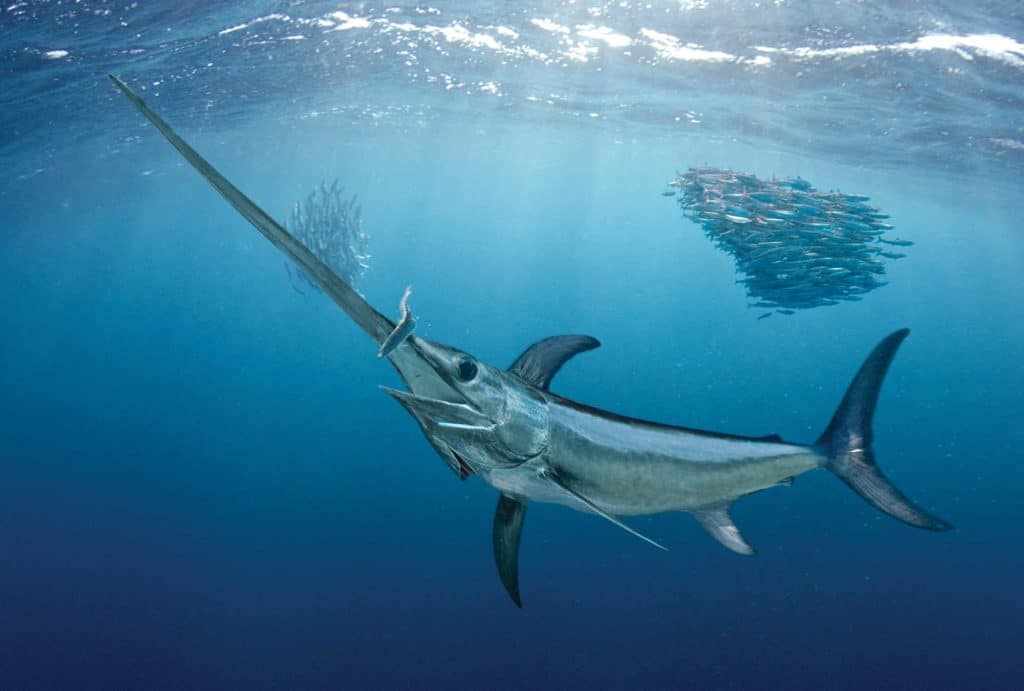
Deep Thoughts
Proficiency catching swordfish deep is affecting other fisheries too. “New England has always considered swordfish a bonus,” says charter captain Jack Sprengel of Rhode Island, where they’re often caught overnight while drifting for tuna. “At sunrise, we’re pulling lures. Around midday, when the tuna bite slows, we would have caught dolphin on high flyers. Now we’re deep-dropping for swords instead,” Sprengel says, but along with swordfish, the fleet catches tuna on the deep rigs.
“Daytime swordfishing is changing the way we tuna fish,” Sprengel adds. “When the trolling bite stops, we’re taking the boat out of gear and pulling yellowfin, bigeye, long-fin (true) albacore — all using methods we traditionally used at night, but deeper. The tuna that guys catch while trolling midday are likely on the surface warming up. Most of the midday feeding is deeper.”
The Deep Scattering Layer — a mass of zooplankton, squid and baitfish that migrates shallower at night to feed and deeper during the day for safety — dictates the depths where swordfish feed around the globe.
“In Grand Cayman, a lot of fishing is in water 5,000 feet deep,” says Capt. Bouncer Smith, but he targets them in the DSL since swordfish have little reason to feed deeper. “We’ll set a buoy rod” — a line suspended at a specific depth by a bobberlike fishing buoy — “at 900 feet, another at 1,200 feet, and then a line off a rod tip between 1,500 and 1,800 feet.”
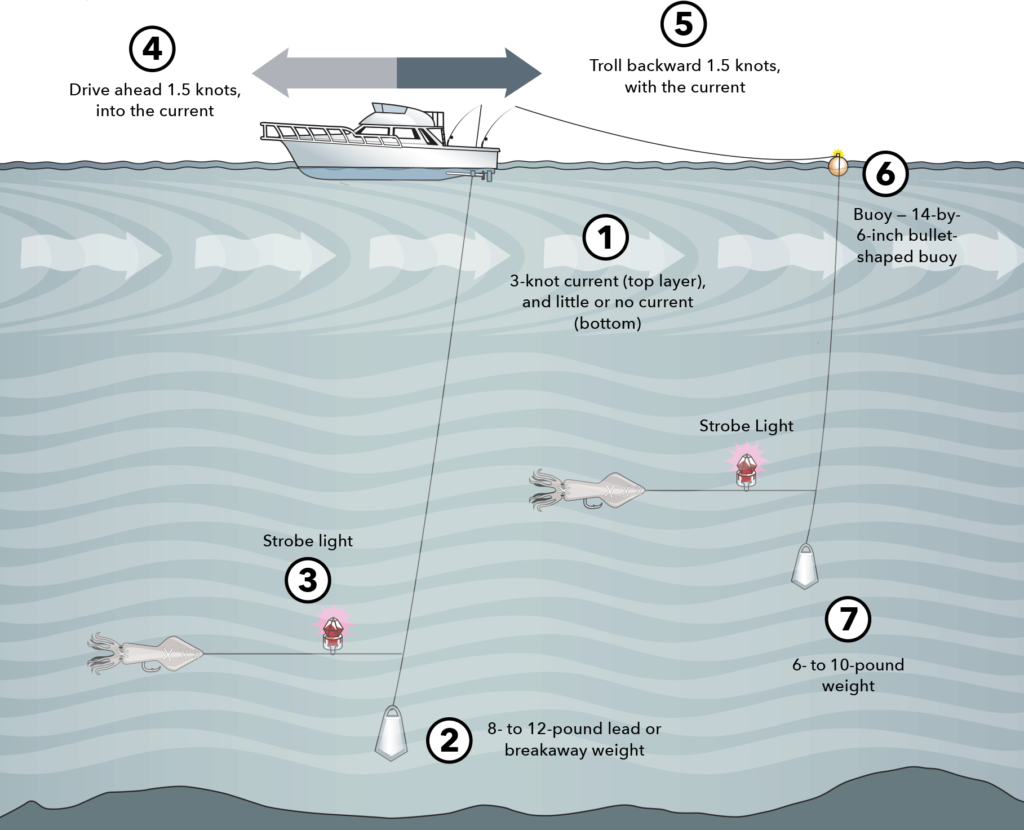
Bumping the boat into forward draws those lines up a bit while covering ground, and going back to neutral lets them settle deeper. Smith has used the same technique elsewhere there is little current, as far away as Ventotene, an island off the west coast of Italy.
In Smith’s home waters off Miami, he deploys one line within 100 feet of the bottom, plus just one buoy line suspended between 1,200 and 1,500 feet deep. Instead of bump-trolling to cover ground, he drives south, into the 3-knot Gulf Stream, just fast enough to maintain a 1.5-knot northward troll.
Bump-trolling has been working well for French recreational angler Samuel Urbain, fishing off Saint-Tropez, France. He was recognized by The Billfish Foundation for tagging the most Atlantic swordfish in 2017 — more than two dozen, with one estimated larger than 240 pounds. Few recreational fishermen target swords off France’s Mediterranean coast, Urbain says. “There are many more fish here than most people believe.”
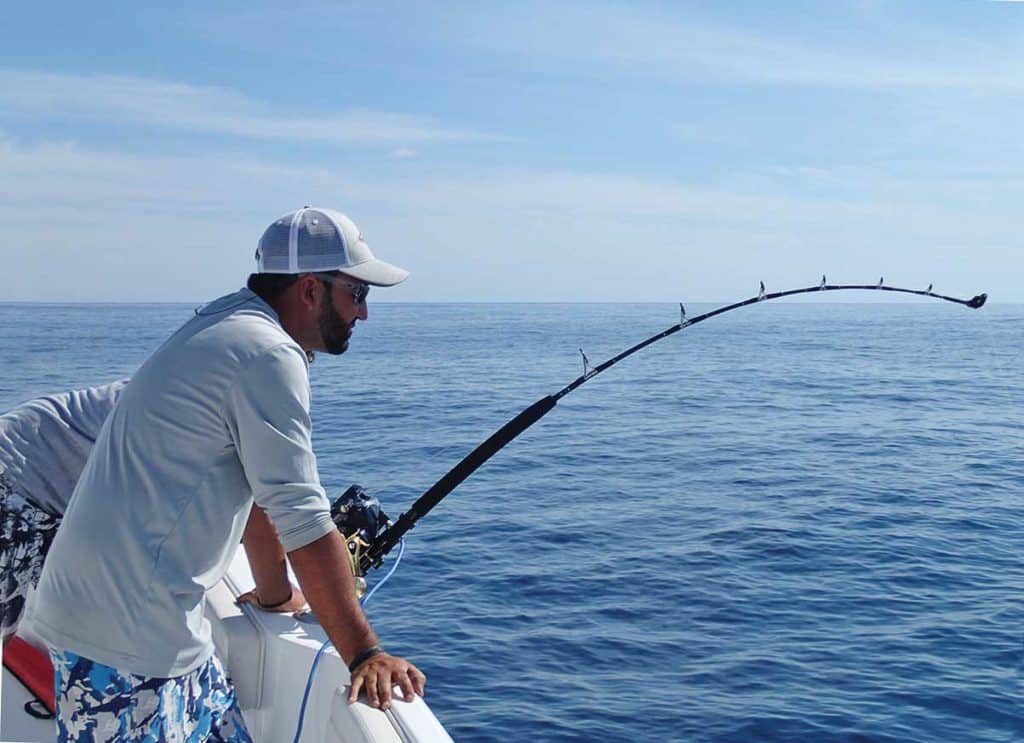
Breaking Away
For daytime swordfish, most captains come back to variants of those two basic techniques — driving into a strong current, or bump-trolling in light current to cover territory.
A third technique was pioneered by Booby Trap owner Brett Holden and his then-captain Jeff Wilson to fish light current off their home port of Freeport, Texas. One light weight 50 to 100 feet from the bait holds the bottom. A second, heavy sacrificial breakaway weight connected directly to the baited hook pulls the rig down without tangles, and that heavier weight is broken off at the bottom.
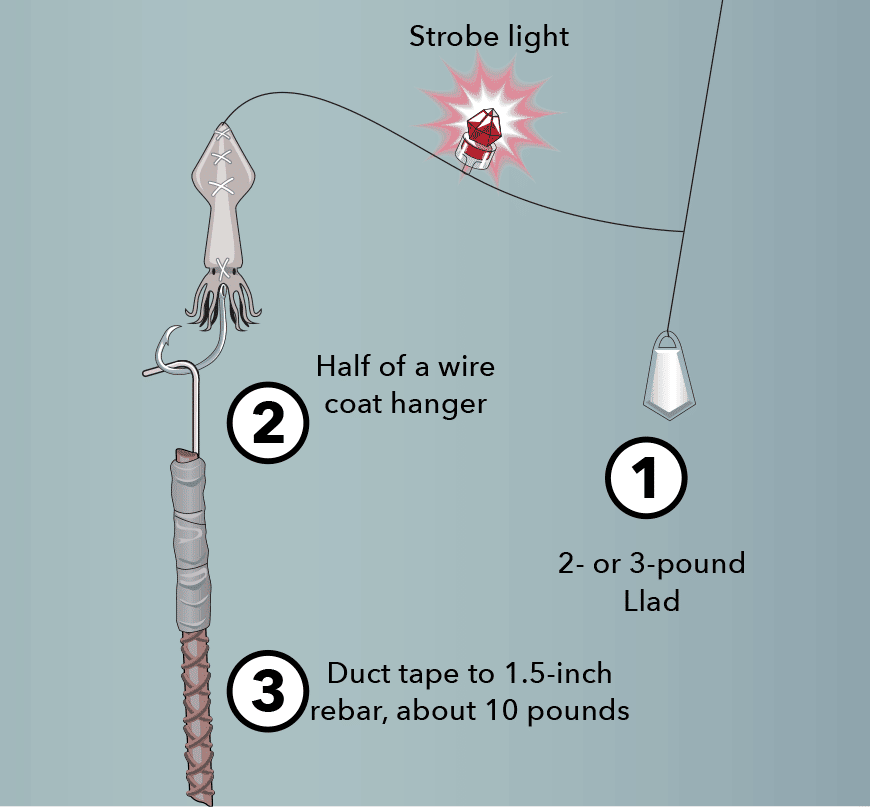
Capt. Peace Marvel, who charters Peacekeeper out of Venice, Louisiana, employs that two-weight system. “I can spot-drop [directly on structure] but fish with much less weight,” he says. His key to success is understanding often-conflicting surface and subsurface currents in the northern Gulf of Mexico. “It’s just like a rock in a river,” Marvel says. “The water creates eddies around that structure.” He typically chooses locations where very light bottom current flows directly into the face of a ledge or hump. “If the current is strong, I’ll do the opposite. I want the current running over the top of it.”
Deep daytime swordfishing actually began in Venezuela with a similar two-weight rig, credited to angler Aquiles Garcia and Capt. Oscar Benito Marcano, where a bag full of rocks broke away at the bottom, and then a lightly weighted line followed the current up the slope of the fabled La Guaira Bank. The first two recorded fantasy slams came there — in 1997, Hank Manley landed all five billfish species in a day aboard Escapade, and in 2004, Rob Ruwitch did the same aboard Sharkey’s Revenge.
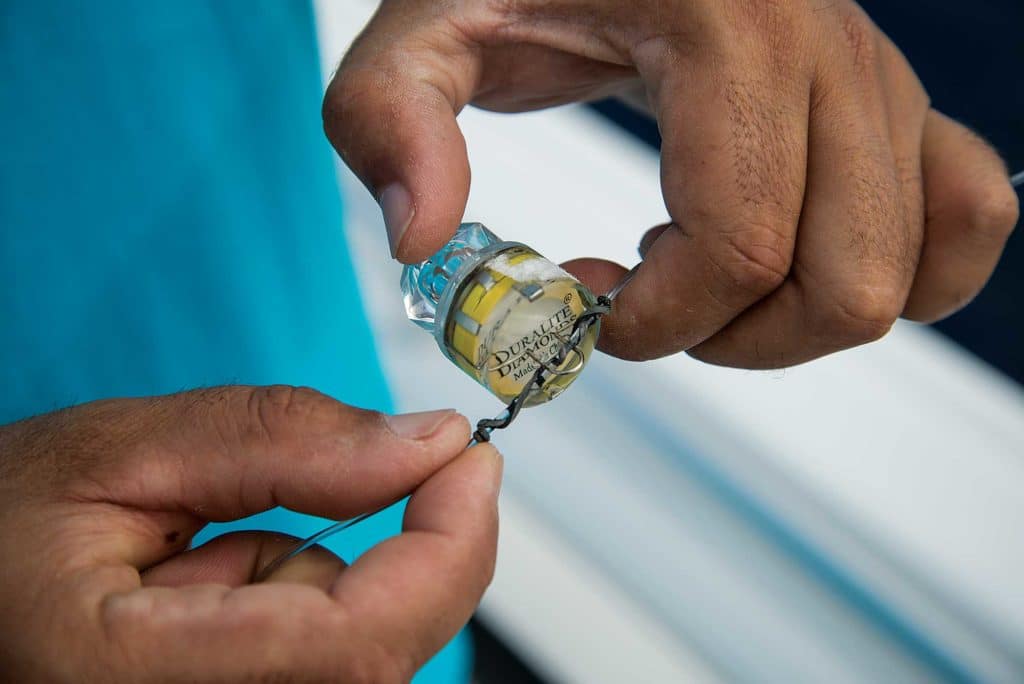
Switch Hitters
The Stanczyks — inspired by Venezuelan success — began catching swordfish in daylight in 2003, but the strong Gulf Stream current off Islamorada would lift a lightly weighted bait off the bottom. Instead, they found that one 12-pound block of concrete, attached 100 feet above the bait with 20-pound monofilament, proved strong enough to hold while fishing but would still break away while fighting a fish.
Now, 15 years later, where current is light enough, Capt. Nick Stanczyk rigs up to 6 pounds of lead so it stays on through the fight. “If I have to go up to 8, 10 or 12 pounds, that’s too much to hand-crank. I’ll do a breakaway — either concrete or rebar.”
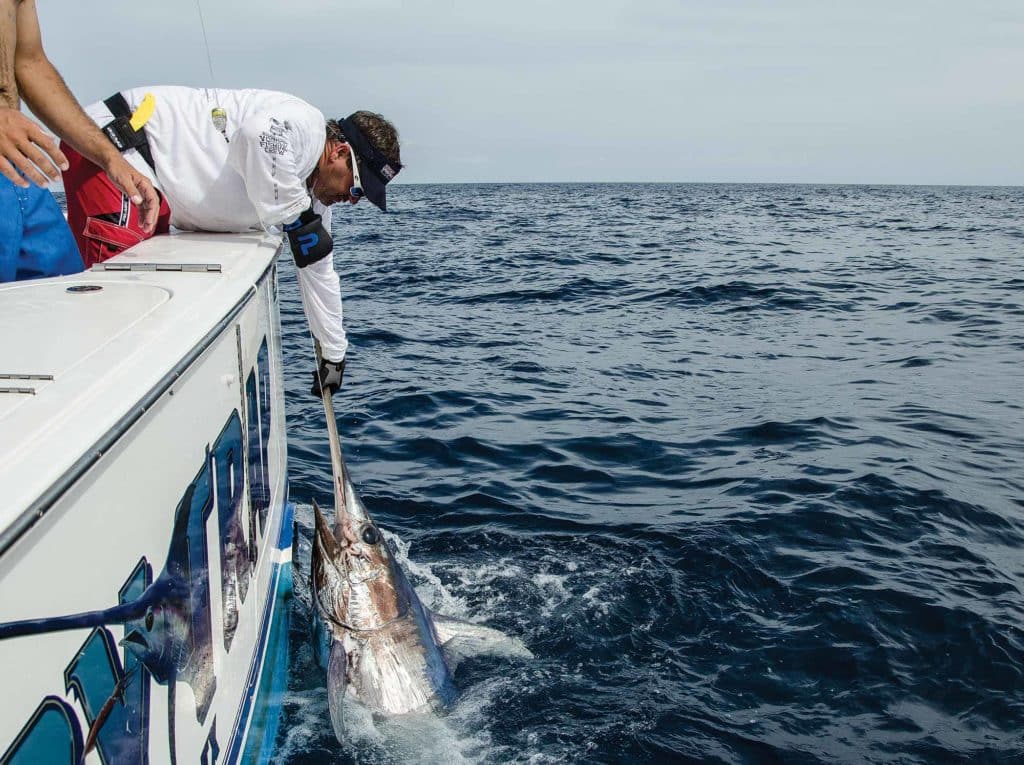
Australia anglers are also battling broadbills. “Swordfishing has really taken off in Australia in the past four years, with Tasmania being at the forefront,” says Capt. Locki Nichols of the large island off Australia’s southeast coast.
“We were deep-dropping with electric reels, targeting ray’s bream, gemfish and blue-eye travalla (aka bluenose, a type of barrelfish), and we were getting smoked by big fish, so we started dropping big baits to find out what was out there.” Besides swordfish, he says, “bluefin tuna, mako and thresher sharks, and blue-eye trevalla are all common bycatch.”
“Being a relatively new fishery, everyone is still developing new techniques,” says Nichols. Fishing out of Eaglehawk Neck aboard Sea Wolf II, Nichols attaches a pair of house bricks to break away similar to Stanczyks’ rig, while others are dropping a Gulf of Mexico two-weight system.
Tasmanian success took hold in Melbourne, across the Bass Strait on the Australian mainland. In 2017, swordfishing expanded considerably up the east coast to Mallacoota, Jarvis Bay, Sydney and as far north as Brisbane. The newest battlefront is in Exmouth, diagonally across the continent on Australia’s northwestern coast.
What’s Old Is New
“I love daytime swordfishing,” says Stephen Seal, a private-boat owner and swordfishing enthusiast, “but it’s highly technical. It’s an intense job watching that rod tip for one little bounce.” So Seal mixes both daytime and nighttime swordfishing. “At night, once you’re drifting, it’s easy. All of a sudden one of your floats moves, and you know you’re hooked up.
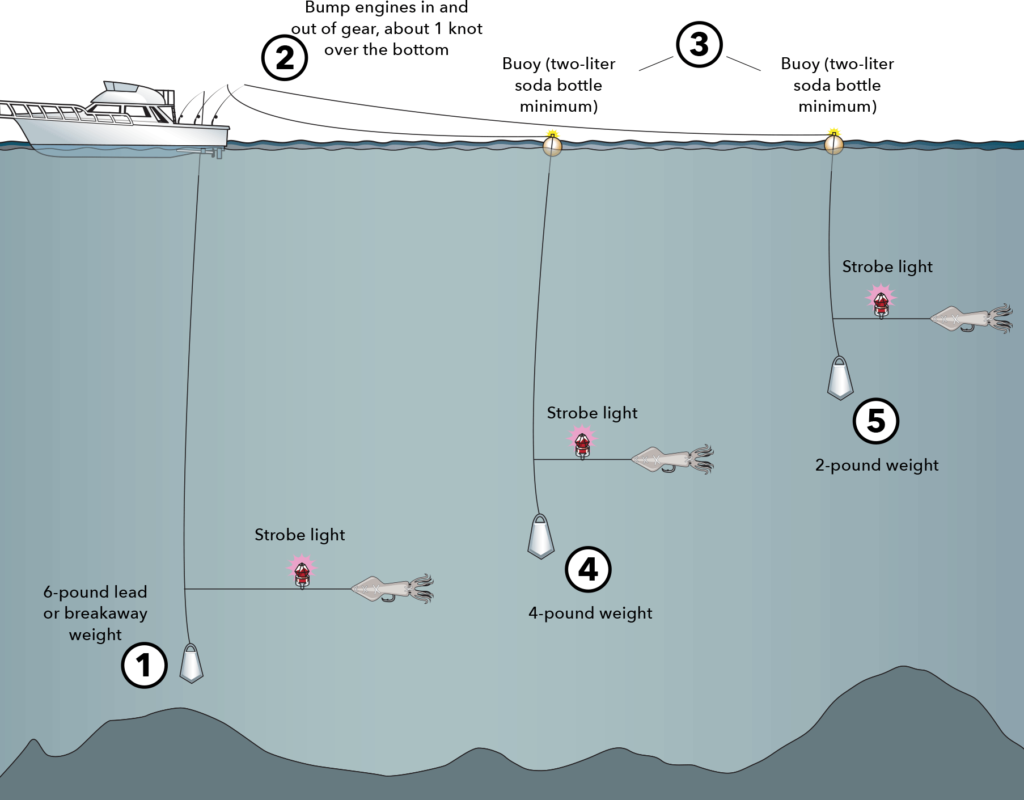
“We might leave a couple of hours before dark, try one or two deep drops, set up our nighttime gear before it gets dark, and be back to the dock by midnight,” Seal says. “There is a peacefulness on the water at night. You’re watching the sunset over the beach, and the lights of Miami. You’re not surrounded by boats. There’s no radio chatter. People on the boat aren’t talking continuously. There’s a serenity you can’t find during the day.”
“Daytime swordfishing can be monotonous,” Boyle adds. “You’re either really into it, or it’s not for you.” He fishes at night for a change of pace but brings along his daytime experience. “We understand the bottom from 12 years of daytime fishing. It changed the game at night. We know where to fish. We know how to drift the wall and draw fish up from deeper water.” Boyle now fishes far deeper than the traditional 300-foot deepest nighttime bait — as deep as 900 feet, with a full moon. “We’re in a new era of nighttime swordfishing. We’re catching more fish, and bigger fish.”
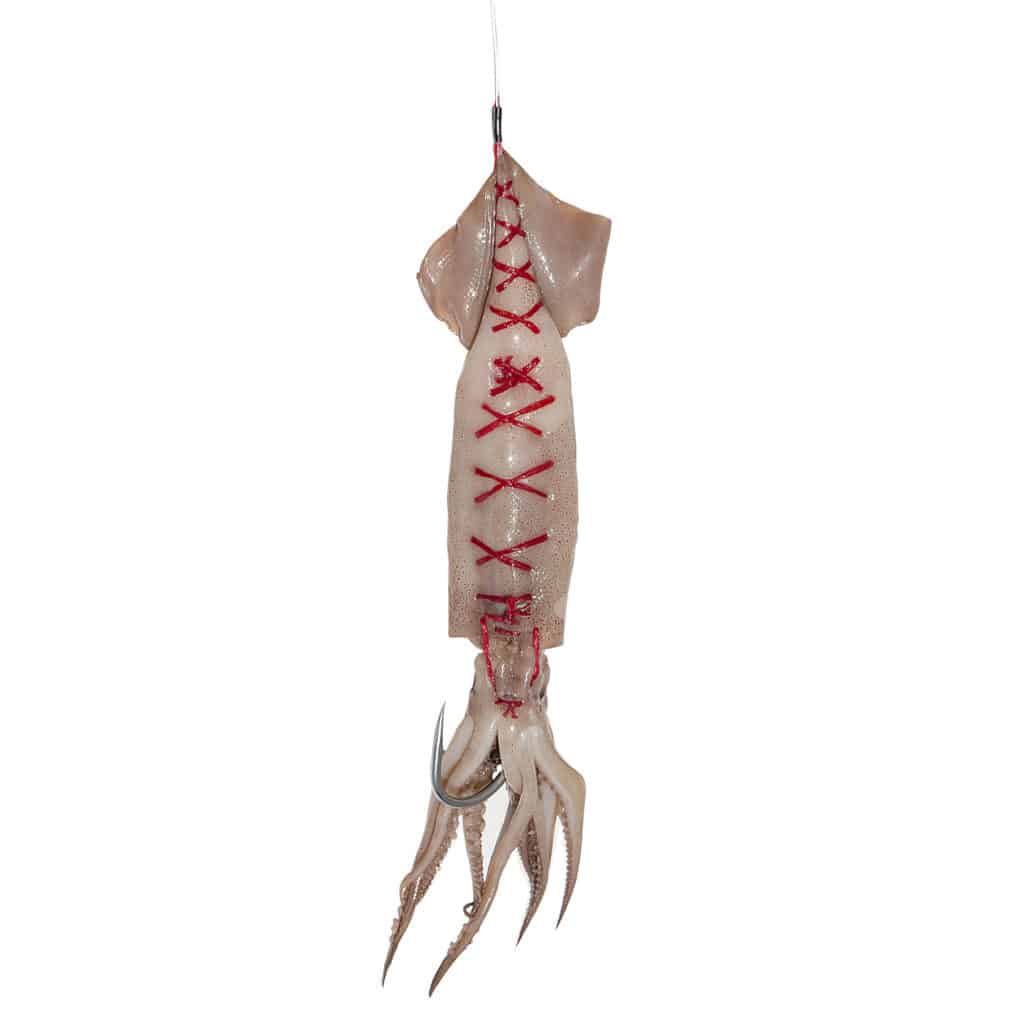
Sunning Swordfish
What’s most remarkable about Wound Up‘s tournament daytime swordfish, cited at the start of this article, is that they duplicated the feat again that afternoon, when another swordfish jumped inside their kite spread. When conditions are right — which they must have been off Miami that day — swordfish surface between deep feeding sprees.
Capt. Todd Mansur, who charters Boardroom out of Dana Point, California, comes from a family with generations of commercial swordfishermen. “When the thermoclines are high in the water, around 20 fathoms, swordfish come up and bask in the sun,” he says. “When thermoclines are deep, they won’t come up [to the surface] at all.”
Shallow thermoclines off Southern California also equate to enhanced albacore fishing. “In a good albacore season, we bait swordfish on the surface almost every day,” Mansur says. Noting that swords’ big eyes don’t see well in bright light, Mansur suggests throwing them a dead or stunned bait, or letting a trolled bait sink a few feet in front of them.

New Battlefronts
A few commercial fishermen in California land daytime swordfish by dangling lines deep beneath buoys that are not attached to a rod and reel. That fishery is strictly regulated, and duplicating it legally with recreational tackle has proved elusive. “With the line detached from the boat, the buoy and bait move naturally, without the boat affecting the drift,” Mansur says. “If someone can figure out how to [replicate that with a rod and reel], we’ll have a tremendous recreational sword fishery here.”
Nighttime trolling is the newest technique to catch on, particularly off South Florida. “We’re trolling planers 30 to 50 feet deep, with a Mold Craft Wide Range and a bonito (little tunny) belly,” explains Bouncer Smith; he credits Capt. Skip Smith (unrelated) for pioneering the technique specifically to catch swordfish on fly tackle.
When a planer trips, an electric reel rapidly brings up the bait, where the crew switches the fish to a pitch bait. In perhaps the ultimate test of teamwork and skill, that switch is done in the dark, with no lights on the boat except legally required running lights.
Read Next: Northeast Daytime Swordfishing
Nighttime trolling is also teaching anglers about midocean swordfish. “Boats are trolling everywhere now,” Smith says. When large sport-fishermen travel long distances, they typically run around 9 knots overnight to conserve fuel. “Everybody is putting out lures — on the way to Bermuda, off Costa Rica, headed down to the Dominican Republic,” he says. And those boats are catching swordfish.
The same boats are also swordfishing during the day after they’ve reached their destinations, particularly in the Caribbean, where deep water starts close to the dock. “In the Dominican Republic, they’re fishing a couple of miles from the marina, in protected bays,” Boyle says. “When it’s too rough to marlin fish offshore, they go swordfishing. Swords are caught half a mile off the beach in Cozumel [Mexico], all the way to Play del Carmen.”
Boyle, fishing with Capt. Paco Vela on Dulce Coco in 2016, boated the Puerto Rican-record 635-pound swordfish barely a mile off San Juan. “These are places we’ll see big numbers of swordfish.”
What excites Boyle most, however, is the thought of so many talented anglers now experimenting in diverse conditions. “Swordfishing is all technique-based, and there will be huge advancements in how we catch them,” he says.
Boyle’s initial efforts, a decade ago, centered on Lindgren-Pitman electric reels. “The LP let me experiment, to figure out the tackle, the weight, how to catch them,” he says, “but hand-cranking is what’s natural to anglers.” His current challenge is light tackle. “I want to be able to regularly catch swordfish in high current on Talica 25s with 30-pound braid.” Virtually everywhere anglers try their hand at swordfishing, it’s common for many to see five or six shots at fish in a day — more bites than most billfishermen enjoy. “It’s the next level of offshore fishing,” Marvel says, explaining why targeting swordfish is spreading so quickly. “They’re living in an environment that is completely unobservable — not like pulling up to a rig and seeing yellowfin busting. It’s a mental challenge, and once they’re hooked, they’ll come straight up to the top and do everything a blue marlin can do, and then go right back down 1,500 feet, and do everything a big tuna can do — and do it twice as hard as either.”








